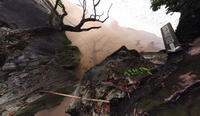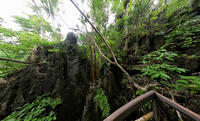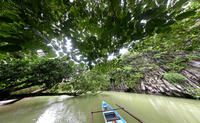You are in: Asia -> Philippines -> Puerto-Princesa Subt... , and traditional search or Image Gallery will yield results of this site only
Puerto-Princesa Subterranean River National Park
| Site number: | 652 |
|
| Type of site: | Natural | |
| Date: | - | |
| Date of Inscription: | 1999 | |
| Location: | Asia, Philippines, Palawan Province | |
Up to 75 images are shown here. Click on each for more details or on Image Gallery for more images.
| Description: | This park includes an impressive limestone karst landscape. The landscape holds a unique underground river that emerges directly into the sea, and is subject to tidal influences in its lower portion. The area also denotes a major habitat for biodiversity conservation. Some of the most important forests in Asia are located with this site which contains a full 'mountain-to-sea' ecosystem. --WHMNet paraphrase from the description at WHC Site, where additional information is available. For 360 degree imaging of this site, click here. | |
| The Puerto Princesa Subterranean River National Park is located about 50 kilometers north of the city of Puerto Princesa, Palawan, Philippines. The National Park is located in the Saint Paul Mountain Range on the northern coast of the island. It is bordered by St Paul Bay to the north and the Babuyan River to the east. The City Government of Puerto Princesa has managed the National Park since 1992. It is also known as St. Paul's Subterranean River National Park. The entrance to the Subterranean River is located a short hike from little town of Sabang. It features a limestone karst mountain landscape with an 8.2 km. navigable underground river. A distinguishing feature of the river is that it winds through a cave before flowing directly into the South China Sea. It includes major formations of stalactites and stalagmites, and several large chambers. The lower portion of the river is subject to tidal influences. The underground river is reputed to be the world's longest. The area also represents a significant habitat for biodiversity conservation. The site contains a full mountain-to-the-sea ecosystem and has some of the most important forests in Asia. It was inscribed by the UNESCO as a World Heritage Site on December 4, 1999. --Wikipedia. Text is available under the Creative Commons Attribution-ShareAlike License. For 360 degree imaging of this site, click here. | ||
| Source: | http://whc.unesco.org/en/list/652 | |
| Reference: | 1. UNESCO World Heritage Center, Site Page. | |





















